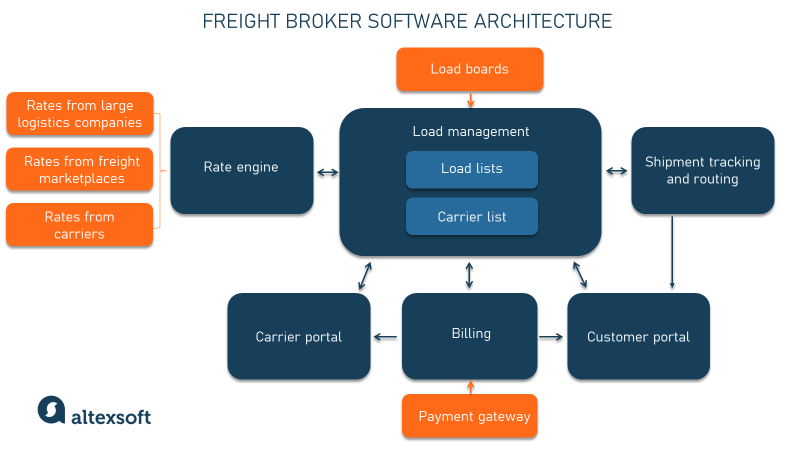Although carriers can work directly with shippers, they rarely do. Both sides prefer to leverage a freight broker as an intermediary. In this article, we’ll talk about the specifics of the freight brokerage business and detail the software that helps brokers effectively manage freight, invoice shippers, and pay carriers.
What is a freight broker?
Freight brokers are the middlemen between shippers and carriers that facilitate communication between the parties, negotiate rates, and make sure freight is shipped safely and on time. Since there are so many financial and liability aspects involved, US freight brokers must be licensed by the Federal Motor Carrier Safety Administration (FMCSA) and have insurance and a security bond.
Carriers, especially less seasoned businesses, often experience hardships finding customers. On the other side, shippers encounter the challenges of choosing a carrier that meets their budget and time constraints, verifying its reliability, and tracking goods until they reach the receiver. That’s why freight brokers are an essential part of the supply chain.
Freight broker vs freight forwarder
Freight forwarders deal with international shipments and often take possession of cargo (as they sometimes store, pack, or consolidate loads), while brokers usually manage shipments within one country, don’t handle freight directly, and only connect the parties.
Freight broker vs freight agent
Freight agents are individuals who, working for the freight brokerage company or under the authority of a licensed freight broker, are responsible for interacting with carriers and customers but don’t deal with financial operations and have little or no liability. Freight agents work on a commission basis while part of revenue generated by their activities goes to the broker for providing administrative support, insurance, etc.
So now that we’ve discussed the basics, let’s look at what exactly freight brokers do.
Freight brokerage operations and challenges
First, a shipper tenders a load for transport at a certain price to a broker. Second, the broker tenders the load at a lower price to a carrier. The end price often varies as carriers can haggle with brokers for a higher reward. Before proceeding, they sign a rate confirmation contract.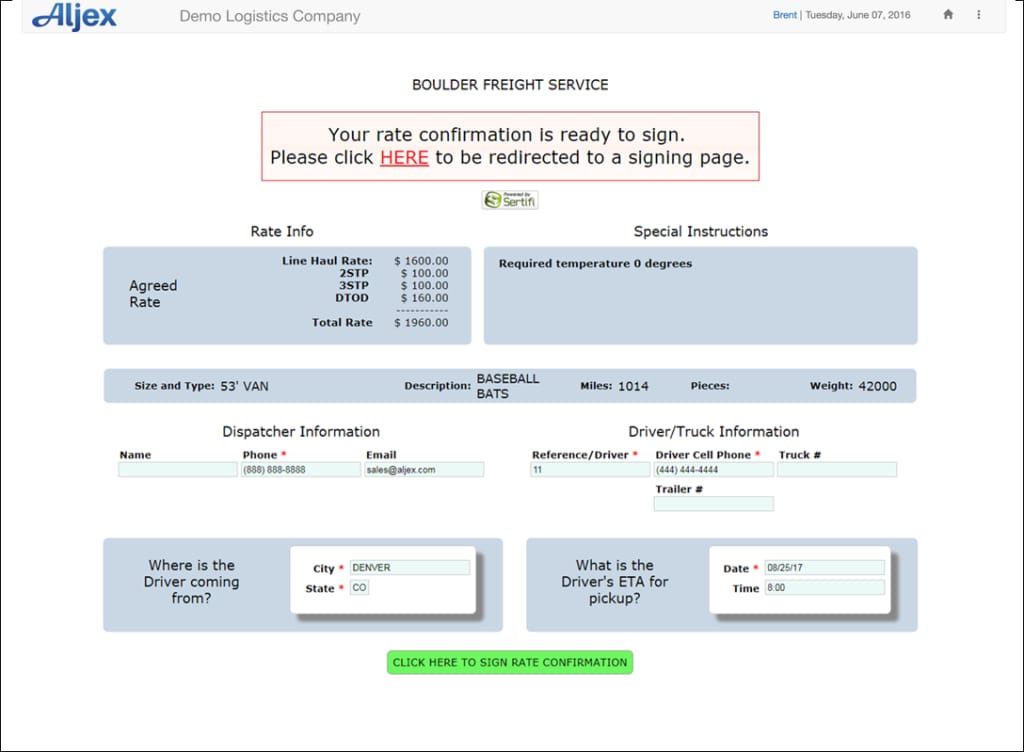
Generated rate confirmation for a carrier, Source: Aljex
The difference between the amount offered by the shipper and the money paid to the carrier is what the broker earns. To ensure profitability, they must define the most efficient transport option that benefits their own business while satisfying customer requirements. Doing this involves many operations, each with its own challenges.
Collecting quotes. Brokers obtain rates from multiple sources. And getting quotes from each separate carrier manually is a time-consuming process.
Balancing between spot and contracted rates. Contracted rates are set rates agreed upon for a certain lane and cargo volume. Spot rates are negotiated on a lane-by-lane, load-by-load basis and can vary wildly. Balancing between them is likely the trickiest part of the freight brokerage business, which often looks like a gamble. There’s hardly any certainty in knowing when to reevaluate contracts, move to another bid for a set lane, or abandon working with a carrier altogether and shift to spot rates as they are more attractive.
Managing carriers and contracts. Working with carriers on a long-term contractual basis, brokers must be aware of when the contract is coming to an end and must be updated.
Supervising delivery. While the shipment is being delivered, brokers track the delivery status and cargo location and keep shippers posted. They also smooth out any issues that may occur on the carrier’s side with timing, damages, or pricing.
Now, let’s see how freight broker software can help perform these operations with maximum efficiency.
Freight broker software modules
Early in the game, brokers can manage their handful of loads manually. But as their network grows, they need to reinvest the initial profit into technologies to scale their business. Specialized software systematizes the shipment process, improves the overall brokerage service offering, and ultimately organizes operations a whole lot better.
Freight broker software is a modular system that typically comprises five key components:
- a load management module to accept loads from shippers and post them to load boards,
- a rate engine to source and assign carrier with most suitable rates,
- customer and carrier portals to keep customers informed and be able to interact with carriers,
- a shipment tracking and routing module to make delivery forecasts and track drivers, and
- a billing module to invoice customers and pay carriers.
Also, the freight broker software interacts with other platforms like shipping marketplaces, logistics management systems, and trucking solutions for carriers. It uses the Electronic Data Interchange or EDI standard to distribute business data among the partner systems. Further, we’ll expand on these interactions while explaining each module one by one.
Freight brokerage software modules
Load management module
A load management module deals with load lists — or lists of available loads carriers can reserve. They contain load descriptions with important information such as the lane, required vehicle type, going rate, and cargo details (type, size, and weight).
The module has different ways to distribute the loads among carriers.
1. Synchronizing with shipping marketplaces like SHIPNEXT or DAT Load Board, it may generate a load list for each of them and simply post it on their trading lists. A broker is notified if a carrier opts for their load. At the same time, the carrier’s details are automatically logged into the system.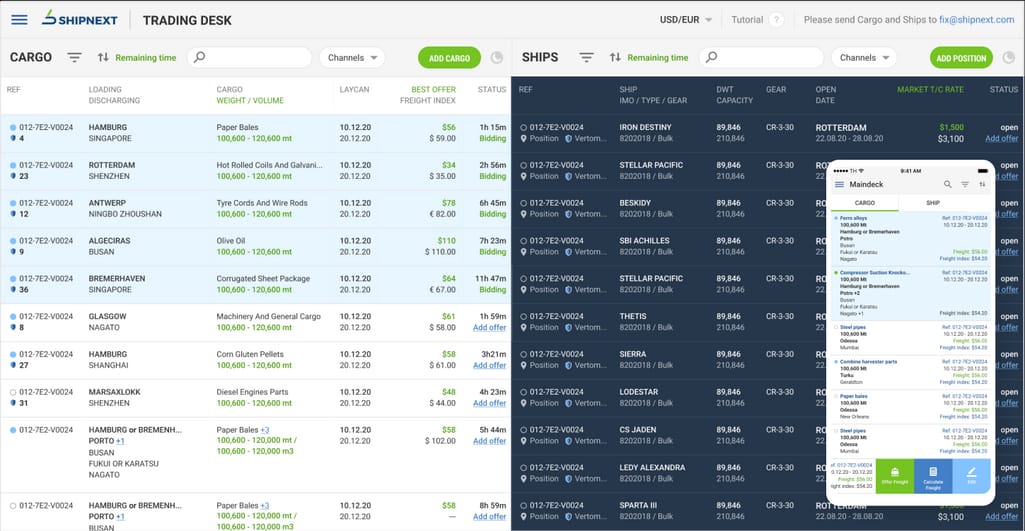
AI-powered trading desk for Cargo-to-Ship matching, Source: SHIPNEXT
2. Another way is to tender loads directly in a carrier’s system if the load matches their experience and their vehicles. In this case, a broker can set up automatic notifications to specific drivers with whom they often work. This requires having a central database to store and manage contacts and details of contracted carriers.
3. Allowing carriers to access the internal load board, the latter will be able to search and book loads directly from the brokerage system.
Keeping track of all the loads in progress is very convenient with a well-organized load management dashboard. It contains tabs to enter all the necessary information such as carrier, customer, pickup and delivery details, including dispatch.
Rate engine
In the rate acceptance process, there are a lot of personalized agreements between brokers and carriers. Although there is no escaping manual operations, a rate engine can streamline a great deal of the quoting workload. It integrates with the APIs of carriers, shipping platforms, and larger brokerages, and pulls rates from all those sources into one place at once.
For carriers that provide contracted rate matrices, brokers can configure a custom tariff in the system. That way, the shipments delivered by these carriers will be automatically rated without the need to manually consult a spreadsheet every time.
Powerful rate analysis and reporting tools aid brokers’ rating decisions. Integrated with multiple shipment sources, freight brokerage software gets access to pools of freight information. Analyzing and comparing historical and real-time freight data, the software recognizes trends within the market before they materialize.
Relying on these findings, brokers can better place or request bids and select the right lane and carrier.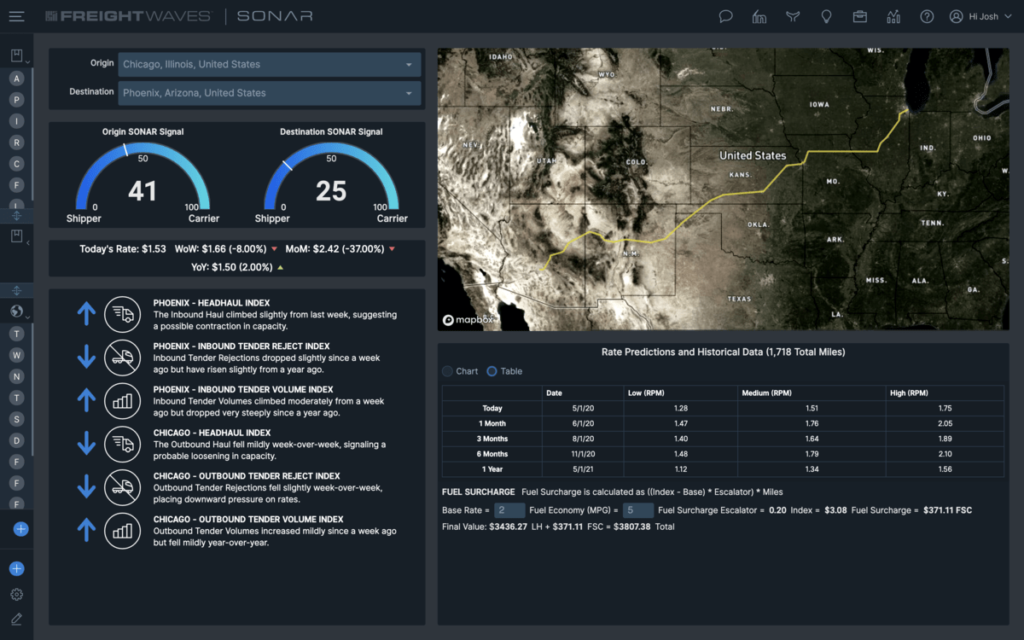
Measuring the value for one lane over another, Source: SONAR
Shipment tracking and routing module
To efficiently negotiate with carriers (or in case of charging customers per mile), brokers need an accurate mileage calculation tool that’s sometimes embedded in a tracking module or integrated from third-party resources like PC*MILER. It has to be designed specifically for trucking so that it considers all the truck-related limitations like low bridges, sharp turns, narrow roads, and so on. It will provide easy-to-read mileage data that can be further displayed to shippers.
Using such a tool, brokers can get realistic arrival times and also view and compare alternative route options making sure a carrier chooses the most practical, shortest, or fastest route.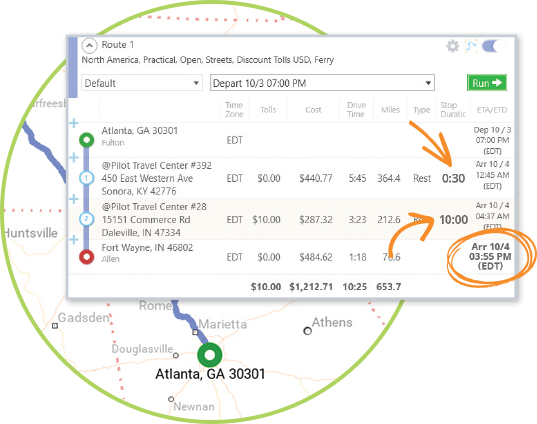
Route planning data, Source: PC*MILER
For the sake of safety and to provide real-time visibility, brokers often ask drivers to accept tracking by a real-time freight visibility platform. If there isn’t one in-house, the software integrates with an external solution like MacroPoint so that a broker is always aware of where the cargo is, avoiding logging into dozens of websites or calling terminals on the phone.![]()
Color-coded map for tracking loads, Source: Aljex
If charging customers per mile, brokers need a mileage calculation tool embedded in a tracking module. It will provide easy-to-read mileage data that can be further displayed to shippers. Using such a tool, brokers can get realistic arrival times and also compare alternative route options making sure a carrier chooses the most practical, shortest, or fastest route, Source: PC Miler
Customer and carrier portals
Most broker software solutions today offer both customer and carrier portals to automate communication with both shippers and transportation providers
Through a customer portal, shippers can tender loads and request quotes. The portal can be integrated with the tracking software to enable customers to track their shipments in real time. Besides that, a portal can have a chat to collect customer feedback or assist shippers without having to pick up the phone or send emails. Through the customer portal, brokers keep customers informed and satisfied. There they can maintain invoicing correspondence and upload all the documents related to a specific load.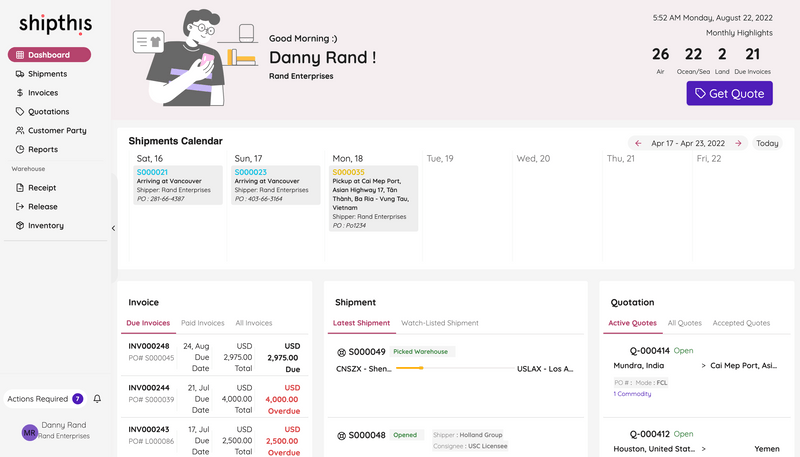
A user-friendly customer portal interface, Source: Shipthis
On the other hand, a carrier portal facilitates interactions with trucking companies. Carriers can view your freight lists, bid on available loads, update delivery status, and upload related documentation directly to your system.
Billing module
A billing module ensures that all parties receive the proper payment. Typically, brokers bill their customers (shippers) first and pay carriers on an ex-post basis. But sometimes, if a broker delays payments or a carrier hasn’t worked with a company yet, they pay COD (cash on delivery).
Synced up with the load page, the billing tool uploads all the necessary data and generates invoices. It also automatically creates other documents like a bill of lading, proof of delivery, and rate confirmation. Via EDI or API connection, brokers can receive invoice data and status updates directly from carriers, and send the invoice data directly to the customer’s system.
We’ve already mentioned the load board where brokers can track the order fulfillment, but it’s also very practical to have a separate billing board to manage load payments. There, brokers can easily spot non-billed loads. Other accounting capabilities include financial reports like income statements, balance sheets, and freight bill audit.
The integration with a payment gateway enables brokers to accept payments from shippers right through the system and manage financial transactions.
Other features that are often included in modern freight broker systems are the CRM, reporting/analytics module, carrier compliance monitoring tool, and so on.
Freight brokerage off-the-rack solutions
If you have a freight brokerage business and decide to purchase software instead of building it from scratch, you have a wide choice of solutions. As they all have similar functionality, a good practice is to select options within your budget range and then try each of them. Make sure the system is highly optimized because speed is everything in this business. Also, don’t commit to a long-term contract right away. It’s better to start with a monthly or quarterly subscription.
Below we review four freight broker systems that are well-known in brokerage circles.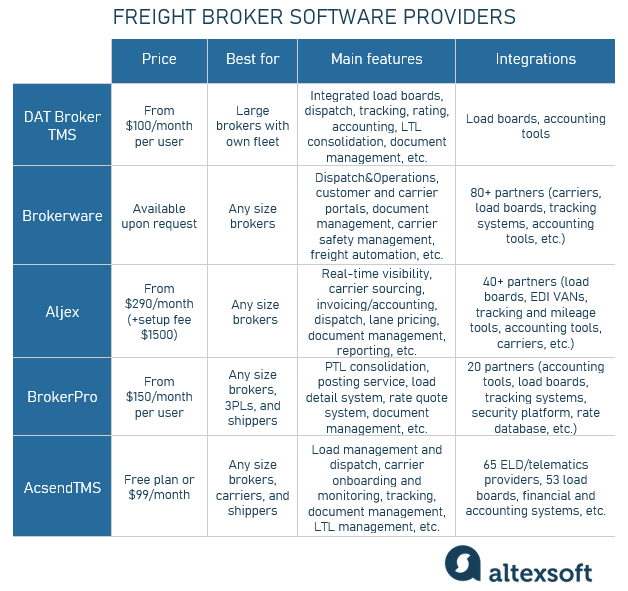
Freight Broker Software compared
DAT Broker TMS
DAT is most known for its load board, but they also offer a transportation management system (TMS) for brokers. They have a good understanding of how brokers work and what they need.
Features. DAT Broker TMS is a suite of integrated operations and accounting and analysis modules. So brokers can enter orders, bill, and settle in a single-entry system. Given that the DAT One Load Board is the market leader that provides access to over 1.7 million trucks, using connected products with seamless load board integration offers a big advantage.
An operations module manages the following truck broker operations:
- order entry,
- dispatch,
- tracking, and
- creating customer and carrier profiles with all the information on them including preferences and history.
An accounting and analysis module automates load billing and helps you manage the overall finances with the following functionality:
- invoices and supporting document management;
- real-time finances view — from transportation expenses and revenues to rent and phone bill;
- reports evaluating customers and carriers' profitability, as well as brokers’ performance; and
- carrier settlement screens with all the updated details.
You can request a demo to explore the features yourself.
Price. The price for the standard Ops package starts at $100 per month and is dependent on the number of users and features you want to include. For a lower fee, you get Broker TMS via the web instead of installing it in-house.
Brokerware by 3PL Systems
Brokerware is a comprehensive platform for managing the full-load life cycle through a single interface. It boasts a rich integrations ecosystem that allows you to easily connect to 80+ carriers, major load boards, tracking systems, accounting tools, and more..
Features. Brokerware covers a lot of operations including the main ones such as
- creating quotes for both contracted and spot rates;
- booking shipments;
- tracking loads;
- generating, sending, and storing important documents (BOLs, labels, dispatch sheets, carrier agreements, invoices, etc.); and
- handling accounting needs.
In addition, Brokerware leverages machine learning technologies to develop recommendation engines and robotic process automation tools that help increase operations efficiency.
The platform also has a CRM included, boasts powerful back-office operations support, and provides separate portals for carriers, customers, and sales agents.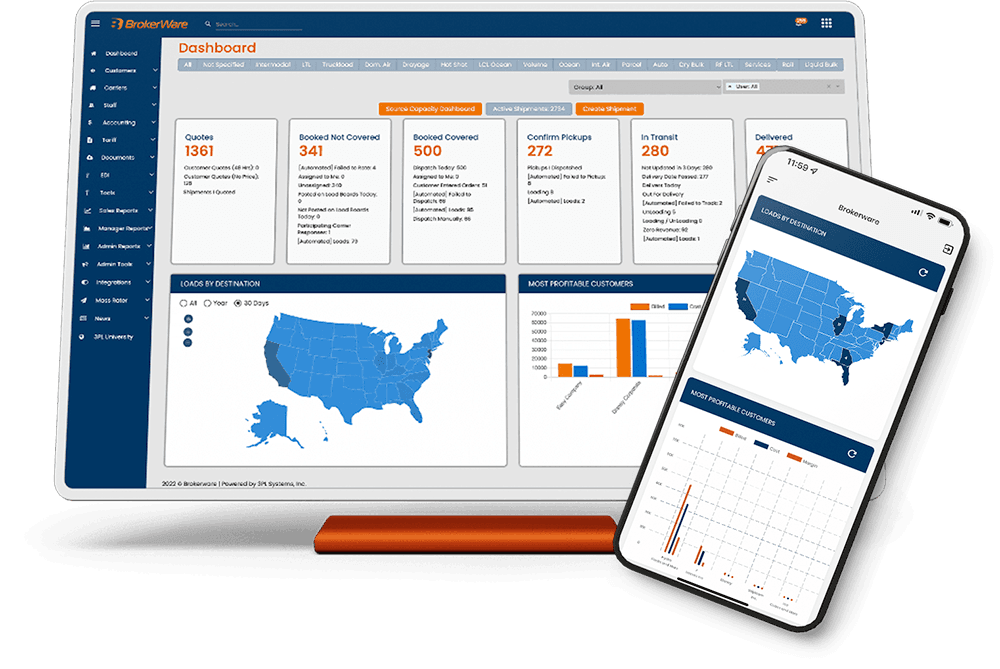
Brokerware menu
Price. Please make direct inquiries.
Descartes Aljex
Descartes Aljex is a cloud-based, dashboard-driven TMS popular across the North American logistics supply chain. It’s used not only by brokers, but also by 3PLs, shippers, and intermodal users.
Features. Aljex helps brokers streamline all the daily operations including carrier search, load board activities, real-time shipment tracking (due to integration with Descartes MacroPoint), dispatch, documentation management, and back office.
Aljex also provides self-service carrier and customer portals and a carrier CRM. In addition, the platform allows users to customize dashboards and generate a range of reports to monitor shipment statuses, performance, and other important metrics.
Most Aljex users report the exceptional convenience and intuitive navigation when using the system. As for integration capabilities, Aljex is connected to all major load boards, mileage calculators, tracking solutions, EDI VANs, common carriers, and other third-party programs.
Price. A basic pricing level is $290 per month in addition to the setup fee of $1,500. There are also standard ($550) and PRO ($1050) options.
BrokerPro by Infinity Software Solutions
BrokerPro is a comprehensive transportation software that helps any size transportation intermediaries – brokers, 3PLs, and shippers – manage their day-to-day operations.
Features. BrokerPro modules include
- Document Manager,
- SMS/Text Messaging,
- PTL (partial truckload) module,
- Infinity Posting Service,
- WebTrack Customer/Carrier Portal,
- Load Tender,
- Invoice, and
- Status Update.
BrokerPro integrates with accounting software QuickBooks, security system SaferWatch, rate database RateView, AI-based solution for funding decisions HubTran, and many more. Each integration is charged separately so you can choose only those connections that you actually need.
Price. BrokerPro’s price depends on the number of users and different modules you add to it. A basic user costs $150.00 per month. Each additional user costs another $40. With the option to pay for certain features, you can customize it to work for your business without spending money on things you do not need. You can learn what the pricing would be for you by filling out the form here.
AscendTMS by InMotion Global
AscendTMS – though very affordable – is a comprehensive management solution for carriers, shippers, and brokers alike
Features. AscendTMS (at least its paid version) offers all the key features freight brokers might need to optimize their workflows:
- Load & Dispatch Management,
- Real-Time Truckload Rate Index with InstaRate,
- Documentation Management,
- Driver Track and Trace,
- Carrier Portal,
- LTL: Direct Wholesale Pricing (the partial truckload management and load planning module)
- Accounting & Financials,
- Reporting, and more.
There’s also an Automated Workflow Engine where users can set up business rules to automate load status updating, notifications, claims processing, and other operations. The Carrier Onboarding & Monitoring module helps easily verify, score, and onboard new carriers.
AscendTMS is integrated with numerous third-party systems including 65 ELD/telematics providers, 53 load boards, financial and accounting systems, and so on.
Price. There’s a free plan for 2 users with over 30 basic features. The Premium plan costs $99/month and is more feature-rich. There’s no user limit and the first 30 days are free. In addition, this provider offers free training and free support.
Digital freight brokerage: replacing brokers
Besides actual intermediaries, companies and truck drivers can also connect via a matchmaking platform with programmed algorithms at its core.
This works for smaller shippers with flexible requirements. Having no long-term contracts, they go on the app and input the delivery details. Having all the info, the digital freight brokerage finds nearby drivers who can accommodate given needs. On the other side, the driver can accept or deny the shipment.
A shipper is matched with a driver within minutes. Once they agree on the terms, a driver can set off right away. Utilizing machine learning, the digital broker can also optimize routes and improve the supply chain.
If you’re interested, check out these platforms:
- Convoy – digital freight network with real-time analytics;
- Transfix – transportation solutions provider with ML-based many-to-many freight matching algorithms and tracking capabilities;
- Uber Freight – Uber technology with instant payments and a rating system to know who you’re partnering with; and
- Loadsmart – a suite of products that help optimize fleet management, procurement, and warehouse management operations.
All the mentioned providers offer robust toolsets for both carriers and shippers to help them efficiently manage their daily operations. This model is a time and cost saver for delivering freight on a one-time, low-cost basis. Still, the bottom line is that digital freight software doesn’t allow for establishing a proper relationship between the shipper and carrier. So right now, it can’t fully substitute the conventional solutions just yet.

Maria is a curious researcher, passionate about discovering how technologies change the world. She started her career in logistics but has dedicated the last five years to exploring travel tech, large travel businesses, and product management best practices.
Want to write an article for our blog? Read our requirements and guidelines to become a contributor.


